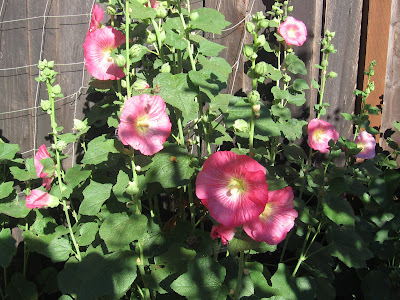
The hollyhocks along the fence are finally coming into their own. These are the second growth stalks that came up after I cut down the towering (ten or twelve feet) spring flagpoles that were not blooming and had acquired a layer of rust, due to the relentlessly cool weather.
This is a popular gathering spot for all manner of bees. Once, I saw a hummingbird inserting its tiny beak along the base of a partially opened blossom -- not inside the flower but outside. It reminded me of the deft skill of my favorite dental hygienist probing my gums. Not the most poetic image, but it does capture the expert precision of the hummingbird at work. Perhaps there are pockets of nectar hidden in the showy blooms even before they open wide?

Here's a wide open blossom, a stunning pink banner unfurled to the sun. Rose pink is thought to be the original color of these ancient medicinal plants. The botanical name, Althaea rosea, comes from the Greek "althos" for "healing."
In medieval Europe, a related plant was used to treat horses. Ailing hocks, the part right above the hoof, were wrapped in the leaves. When crusaders came back from the Holy Land, bearing the botanical cousin of this hock plant, the new arrival came to be known as the "holy hock."

The dramatic knob in the center of the blossom contains both stamen and pistils and the plant is self-pollinating. Bees love the abundant pollen so cross-pollination occurs. I have often watched the giddy buzzing things burying themselves in one blossom after another.
Maybe cross pollination accounts for the range of colors that have evolved from the original seeds from plants with dark red blooms given by a friend from the south Bay. They grew in our yard as dark pink at first, then diversified into a range of dark pink to pale pink to white.

Pale pink and white blooms showed up this year for the first time -- the third season since the original planting.
Supposedly the "holy hock" brings good fortune and abundance to homes where it is planted nearby. Planting some certainly brings an abundance of hollyhocks, since they grow back from the base and also produce myriad seeds. In our yard, the row along the fence is well established and seedlings are popping up here and there.












